45 Flowering Trees for California: Identification Guide with Pictures
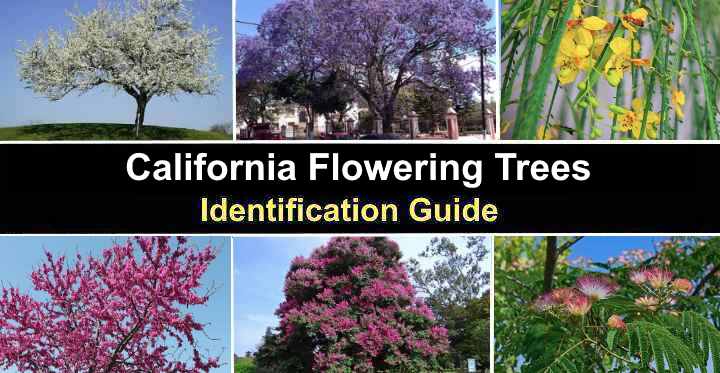
Flowering trees in California make a stunning aesthetic addition to any southwestern garden. Many native trees thrive in the warm climates of California. Flowering tropical deciduous and evergreen trees enhance garden landscapes with colorful blooms, lush foliage, and sweet scents all year round. Additionally, tall trees with flowers make excellent shade sources in the Golden State.
Whether you live along the coast in San Francisco, San Jose, Los Angeles, Malibu, or San Diego, varieties of flowering trees will thrive in your front or backyard. Or suppose you live inland in Sacramento or at the foothills of the Sierra Nevada or San Gabriel mountains. In that case, you can choose from a wide variety of trees with spectacular fragrant, colorful blooms.
This article is an identification guide to the different types of flowering trees in California. Descriptions and pictures of trees that provide vibrant color to landscapes throughout the Golden State will help you choose the best species for your garden landscape.
What Are Flowering Trees?
Flowering trees are plants with a trunk, crown of leafy foliage, and beautiful flowers that bloom in the spring, summer, or fall. Flowering trees in California have stunning blossoms in purple, red, yellow, white, and pink shades. In addition, planting flowering trees in your yard attracts pollinators and wildlife and fills landscapes with floral scents.
Planting flowering trees in a southwestern garden also has an additional benefit—shade. Leafy trees with colorful blooms help to keep gardens cool during hot, dry summers along the Pacific Coast. Also, they provide some protection from coastal winds or strong breezes that come from mountain ranges to the east.
Growing Zones For Flowering Trees in California
Before selecting the best trees to plant in your southwestern garden, it’s important to know about growing zones in California. The climate in California is like the Mediterranean, with warm, dry summers and wet winters.
The growing zones in California are divided into northern and southern zones. The northern regions of California can range from USDA zones 5 to 8. Typically, colder California zones are inland east of Sacramento and Redding.
The southern regions of California are typically zones 8 to 11. These include cities like Santa Barbara, Los Angeles, and Palm Springs, as well as deserts like the Joshua Tree National Park and the Mojave Desert.
However, it’s good to note that most of the Pacific Coastline from San Diego in the south to San Francisco in the north falls in the USDA 8 to 11 range.
How to Choose Flowering Trees in California
When selecting a flowering tree for your California landscape, the most important considerations are the cold hardiness zone, sun exposure, soil type, and mature tree size. Flowering trees typically require planting in fertile soil that allows for good drainage. Additionally, check salty air tolerance—vital if you live near the Pacific Coast.
When choosing a flowering tree for a California garden landscape, what else is there to consider? First, decide if you want a deciduous or evergreen tree. Even in warm climates, many deciduous trees shed leaves in the fall or dry seasons. Therefore, you may have to do an annual cleanup when the leaves drop.
Flowering Trees in California (with Pictures) – Identification
California is known for its diverse and beautiful landscapes, which include many varieties of flowering trees. From the vibrant purple blossoms of the jacaranda tree, California lilac, and desert willow trees to the fragrant white flowers of the evergreen pear tree, many types of flowering trees thrive throughout the Golden State.
Blue Jacaranda (Jacaranda mimosifolia)
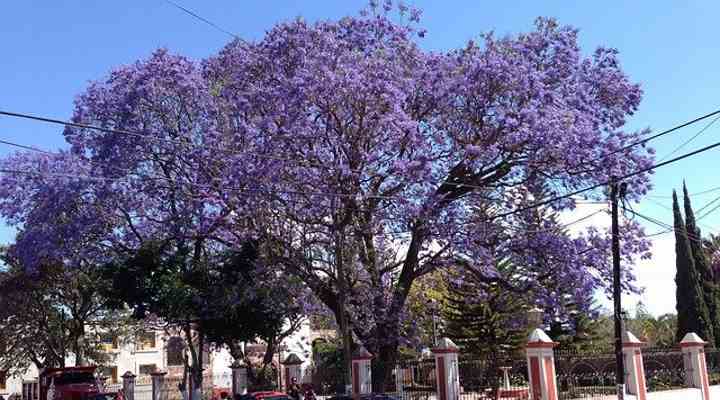
Jacaranda tree has beautiful purple flowers and can be grown in the southernmost parts of California
The blue jacaranda is a purple-flowering tree that fills California landscapes with dramatic displays of lilac, lavender-blue, and purple flowers. Also called the fern tree, this deciduous tree has fragrant trumpet-shaped flowers in conical clusters. Its fern-like, deep green foliage and spreading canopy are ideal for shade on hot summer days.
Ideal for California’s dry climates, the blue jacaranda tree thrives in USDA zones 10 and 11. It’s a moderately fast-growing tree with an open, spreading crown forming a large umbrella-like canopy.
With its purple flowers, the stunning jacaranda tree grows 25 to 50 ft. (7.5 – 15 m) tall and 15 to 30 ft. (4.5 – 9 m) wide. It is ideal as a lawn or shade tree in Southern California, where it can flower throughout the year.
Blue jacaranda is also a flowering tree native to Florida.
California flowering tree color: Large, showy flower clusters in shades of lilac, purple, and pale blue.
California flowering tree identification: The jacaranda tree has a wide, spreading, rounded crown with purple flowers.
- USDA Growing Zone: 9b-11
- Size: 25 to 50 ft. (7.5 – 15 m) tall and 15 to 30 ft. (4.5 – 9 m) wide
- Light: Full sun
- Soil: Well-draining, fertile soil
- Flowering Season: Late spring to early summer
Crape Myrtle (Lagerstroemia)
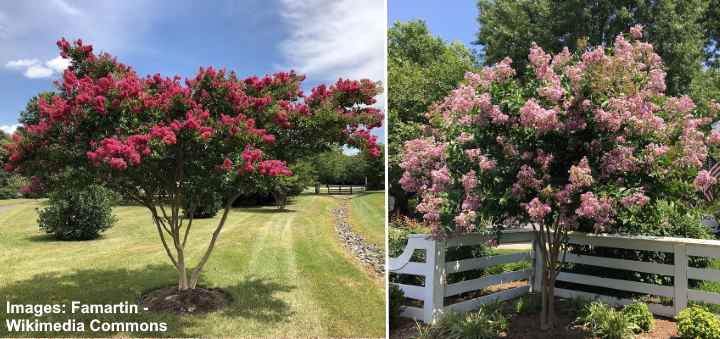
Crape myrtles are small flowering trees that grow best in full sun and are suitable for compact spaces
The crape myrtle is a popular flowering small tree in California, with vibrant and colorful pink, red, white, and purple blooms. This deciduous shrub-like tree is known for its showy flower clusters and deep green foliage that turns bronze in the fall. Crape myrtle flowers have a long blooming time, and the tree is small enough to grow in compact gardens.
Crape myrtle trees and shrubs grow 8 to 15 ft. (2.4 – 4.5 m) tall and 6 to 10 ft. (1.8 – 3 m) wide. They are known for their rounded canopy with dense foliage and clusters of ruffled pink or purple flowers. Grow in full sun in USDA zones 7 to 9.
Crape myrtle is also on the list of native Texas flowering trees.
California flowering tree color: Crape myrtle flowers are pink, red, white, or purple.
California flowering tree identification: The Crape myrtle tree is a multi-stemmed tree with peeling light-brown bark, oval leaves, and clusters of papery flowers.
- USDA Growing Zone: 7-9
- Size: 8 to 15 ft. (2.4 – 4.5 m) tall and 6 to 10 ft. (1.8 – 3 m) wide
- Light: Full sun
- Soil: Well-drained, slightly acidic
- Flowering Season: Summer to fall
Texas Mountain Laurel (Sophora secundiflora)

The Texas mountain laurel is a purple flowering tree that is suitable for full sun or partial shade in California Gardens
The Texas mountain laurel is a beautiful flowering shrub that can be trained as a beautiful ornamental tree in California. This evergreen tree has fragrant purple flowers that grow in dangling clusters. In addition, the heat-loving tree has fuzzy seed pods that dangle from the tree. Texas mountain laurel tolerates heat, poor soil, and arid conditions.
Suitable for planting in USDA zones 7 through 10, Texas mountain laurel grows 15 to 25 ft. (4.5 – 7.5 m) tall and up to 10 ft. (3 m) wide. It’s a small, slow-growing flowering tree, useful as a specimen or patio tree in xeriscape landscapes.
California flowering tree color: The Texas mountain laurel has clusters of fragrant purple flowers that bloom in the spring.
California flowering tree identification: The Texas mountain laurel has an upright growth habit with glossy green foliage, fragrant purple blossoms, and gray fuzzy seed pods.
- USDA Growing Zone: 7-10
- Size: 15 to 25 ft. (4.5 – 7.5 m) tall and up to 10 ft. (3 m) wide.
- Light: Full sun to partial shade
- Soil: Well-drained, dry, rocky soil
- Flowering Season: Spring
Evergreen Pear (Pyrus kawakamii)
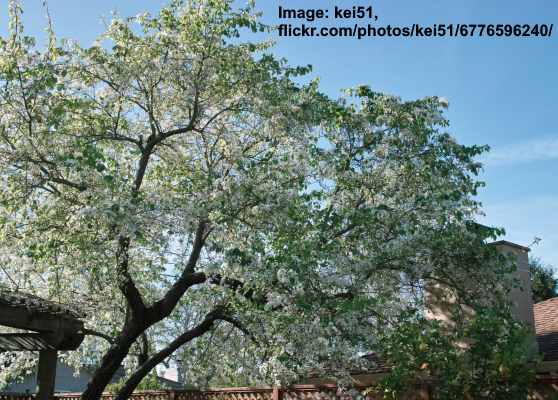
Evergreen pear is a white flowering ornamental tree common in southern California
The evergreen pear tree is a popular ornamental flowering tree for Southern California landscapes. Identifying features of the tree are its glossy green foliage and spectacular, intensely fragrant white flowers, followed by greenish-brown inedible berry-like fruits. This small decorative fast-growing evergreen tree grows 15 to 30 ft. (4.5 – 9 m).
Also called the Callery pear, the ornamental evergreen pear tree is suitable for planting in USDA zones 8 through 10. It can tolerate heat, drought, and windy conditions. With its broad, rounded habit, the ornamental tree is common in cities like Santa Barbara, San Diego, San Francisco, and Sacramento.
California flowering tree color: The evergreen pear tree produces white flowers with a pungent, sometimes overpowering fragrance.
California flowering tree identification: The Callery pear tree has an upright growth habit, furrowed gray bark, with glossy green foliage, white spring flowers, and small round, inedible brown fruits.
- USDA Growing Zone: 8-10
- Size: 15 to 30 ft. (4.5 – 9 m)
- Light: Full sun
- Soil: Well-drained, fertile soil
- Flowering Season: Spring
California Buckeye (Aesculus californica)

The outstanding feature of California buckeyes is their spectacular white flower spikes
The California buckeye is a small flowering tree native to California with masses of sweetly-scented clusters of creamy-white flowers. The fragrant floral displays are on show in late spring and early summer and contrast nicely with attractive green foliage. After flowering, spiky pear-shaped seed pods have one or two brown seeds appear.
California Buckeye trees grow 15 to 30 ft. (4.5 – 9 m) tall and wide and are suitable for planting in USDA zones 7 and 8. The small ornamental trees thrive in full sun or partial shade. The trees are also drought-tolerant and can tolerate poor soils. However, they shed their leaves in California’s hot summers.
California flowering tree color: The California buckeye produces white to pale pink flowers that bloom in the springtime.
California flowering tree identification: The California buckeye has a flattened canopy, palmately compound leaves, and clusters of fragrant white or pale pink flowers.
- USDA Growing Zone: 7-9
- Size: 15 to 30 ft. (4.5 – 9 m) tall and wide
- Light: Full sun to partial shade
- Soil: Well-drained, loamy, sandy soil
- Flowering Season: Late spring to early summer
Western Redbud (Cercis occidentalis)
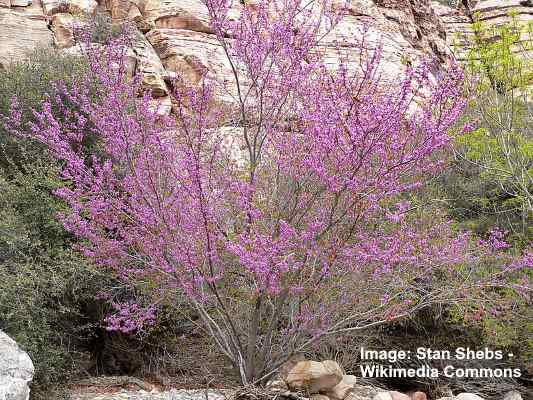
The pink flowering western redbud tree is native to California and is small enough for landscaping compact gardens
The western redbud is a native California flowering tree with masses of bright pink pea-like flowers in the spring. Other identifying features of the ornamental tree are heart-shaped leaves, purple-brown seed pods, and twisted or contorted branches. Additionally, it has foliage that turns rusty yellow in the fall.
Suitable for planting in USDA zones 6 to 9, the drought-tolerant western redbud is a great choice for xeriscape landscapes or as an ornamental specimen tree in compact gardens. It grows 10 to 15 ft. (3 – 4.5 m) tall and wide.
California flowering tree color: The western redbud produces clusters of bright pink flowers on bare branches in the spring.
California flowering tree identification: Identifying features of the native Californian western redbud are a vase-shaped habit, zigzag branches, smooth gray bark, and yellowish bronze fall foliage. Its outstanding feature is the showy pink floral displays in spring.
- USDA Growing Zone: 6-9
- Size: 10 to 15 ft. (3 – 4.5 m) tall and wide
- Light: Full sun to partial shade
- Soil: Well-drained, loamy soil
- Flowering Season: Spring
Desert Willow (Chilopsis linearis)
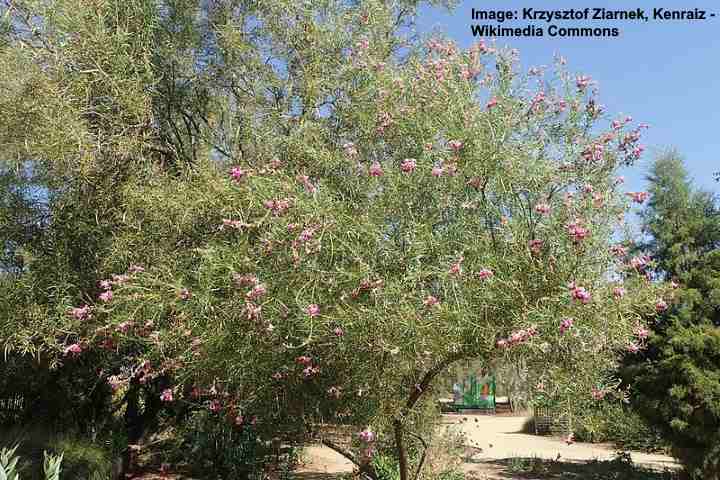
Desert willow is a small pink flowering tree native to California. In this picture: Chilopsis linearis ‘Timeless Beauty’
The desert willow is native to California and the southwest US. It is a stunning flowering tree with pinkish trumpet-shaped flowers. This desert tree’s identifying features are its showy clusters of tubular flowers, narrow, willow-like leaves, and spreading growth habit. In addition, its shaggy bark and twisting branches create visual interest in winter.
The native desert willow tree thrives in USDA zones 7 to 11 in full sun and well-drained soils. Its drought and heat tolerance make it suitable as an ornamental tree in backyards, patios, and container gardens in southwestern landscapes.
California flowering tree color: The desert willow produces fragrant flowers in shades of pale or deep pink or pale purple.
California flowering tree identification: The characteristics of desert willow are its twisted branches, glossy green linear leaves, trumpet-shaped pink flowers, and long, dangling seed pods.
- USDA Growing Zone: 7-11
- Size: 15-30 feet (4.5 – 9 meters) tall and wide
- Light: Full sun
- Soil: Well-drained, sandy, or rocky soil
- Flowering Season: Late spring to early summer
Mexican Palo Verde (Parkinsonia aculeata)
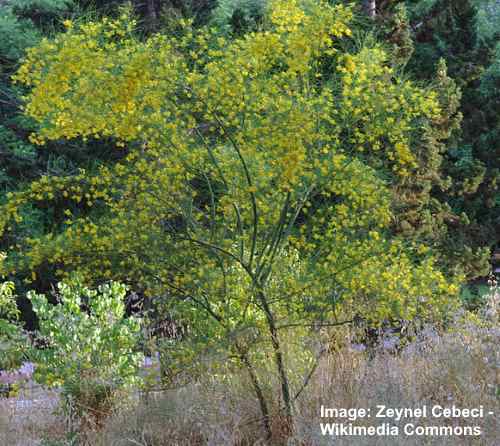
Mexican palo verde is a yellow flowering drought tolerant tree native to California
Also called the Jerusalem thorn, the Mexican palo verde is a native California flowering tree that produces bright yellow flowers. The golden yellow flowers bloom en masse in warm weather and after heavy rainfall. These yellow blossoms are followed by 3” to 5” (7 – 12 cm) long seed pods.
The Mexican palo verde tree gets its name from its unusual green bark. The decorative trees grow 15 to 20 ft. (4.5 – 6 m) tall in USDA zones 8 to 11. It is a drought-tolerant native tree that thrives in full sun
California flowering tree color: The Mexican palo verde produces bright yellow flowers with five petals each, blooming in warm months and after rainfall.
California flowering tree identification: Identifying features of the Mexican palo verde include its spreading canopy, feathery “see-through” sparse foliage, and sprays of showy yellow flowers.
- USDA Growing Zone: 8-11
- Size: 15-20 feet (4.5 – 6 meters) tall
- Light: Full sun
- Soil: Well-drained, sandy, or loamy soil
- Flowering Season: Warm months and after rainfall
Blue Palo Verde (Parkinsonia florida)
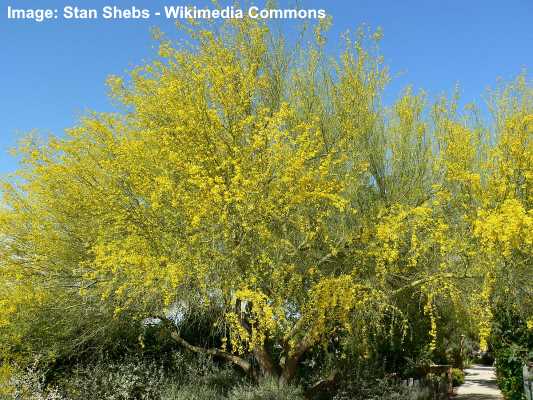
Blue palo verde is native California tree with masses of yellow flowers
Native to California, the blue palo verde has spectacular yellow flowers growing on green branches. Dry conditions in California’s southern regions mean the small, pinnately compound leaves only grow for short periods. The papery golden yellow flowers measure 2” to 4” (5 – 10 cm) and give way to long finger-like seed pods.
Blue palo verde has an upright, spreading growth habit and grows up to 20 to 25 ft. (6 – 7.5 m) tall in USDA zones 8 to 11. The ornamental tree is a great choice for compact gardens as a specimen tree.
California flowering tree color: The blue palo verde tree has bright, golden-yellow flowers with hints of orange in the throat.
California flowering tree identification: Identifying features of the blue palo verde are blue-green bark, small oval leaves, and masses of brightly colored yellow flowers.
- USDA Growing Zone: 8-11
- Size: 20-25 feet (6 – 7.5 meters) tall
- Light: Full sun
- Soil: Well-drained, sandy, or loamy soil
- Flowering Season: Spring to early summer
Western Chokecherry (Prunus virginiana var. demissa)
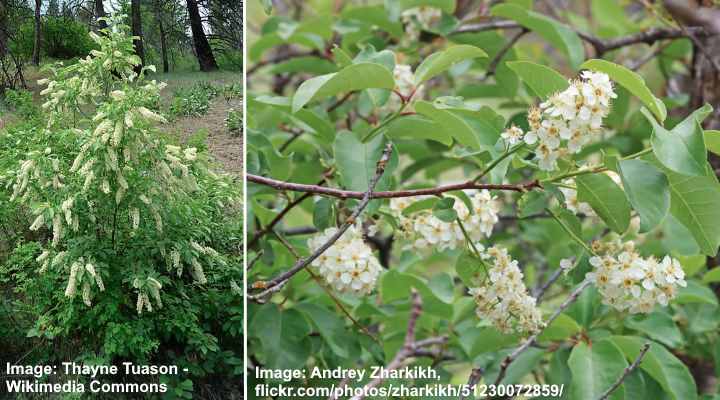
Western chokecherry young tree (left image) and flower clusters (right)
The western chokecherry is a native flowering tree to the southwest known for its attractive conical clusters of six-petaled white flowers. The small shrub-like tree thrives throughout the Golden State. It is identified by its lanceolate green leaves, creamy-white flowers, and edible dark red to black fruits.
As an attractive small suckering tree with white flowers, western chokecherry thrives in USDA zones 5 to 10. It grows up to 20 ft. (6 m) tall and wide. It’s a great choice for gardens, patios, or container gardens due to its showy white flowers and edible fruit.
California flowering tree color: Clusters of white flowers with orange and yellow centers adorn the western chokecherry tree.
California flowering tree identification: The small western chokecherry tree or thicket-forming shrub has oval, lance-shaped leaves, white flower clusters, and black drupes.
- USDA Growing Zone: 5-10
- Size: Up to 20 feet (6 meters) tall and wide
- Light: Full sun to partial shade
- Soil: Well-drained, loamy soil
- Flowering Season: Late spring to early summer
Blue Elderberry (Sambucus mexicana)
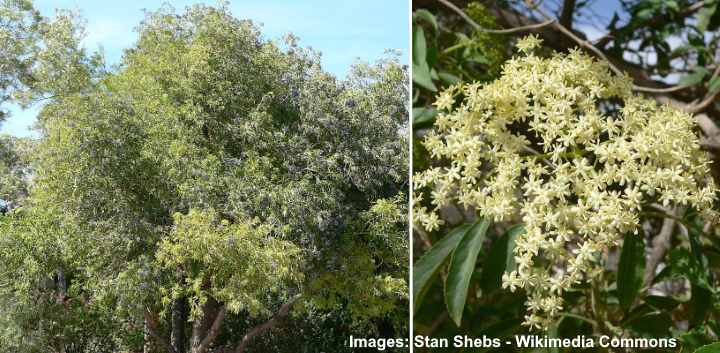
Blue elderberry is a decorative tree with creamy white to pale yellow flower clusters that is native to California
The blue elderberry is an easy-to-grow small tree or deciduous shrub with clusters of creamy-white to pale yellow star-shaped flowers. This attractive berry-producing tree has flat-topped flower clusters that give way to abundant bunches of purple berries in the fall. The small, deciduous tree grows 20 to 30 ft. (6 – 10 m) tall and wide.
This native California flowering tree thrives in USDA zones 5 to 9. It has an upright spreading canopy forming a loose vase shape. This drought-tolerant tree is a great choice for gardens with poor drainage. Although it thrives in full sun, it can tolerate shade and poor soils.
California flowering tree color: The blue elderberry flowers are large umbels of pale yellow to creamy-white flowers.
California flowering tree identification: Identifying features of the blue elderberry include its spreading canopy, lance-shaped glossy green leaves, conical clusters of pale yellowish flowers, and edible dark blue berries.
- USDA Growing Zone: 5-9
- Size: 20-30 feet (6 – 10 meters) tall and wide
- Light: Full sun to partial shade
- Soil: Well-drained, loamy soil
- Flowering Season: Late spring to early summer
Mimosa Tree (Albizia julibrissin)
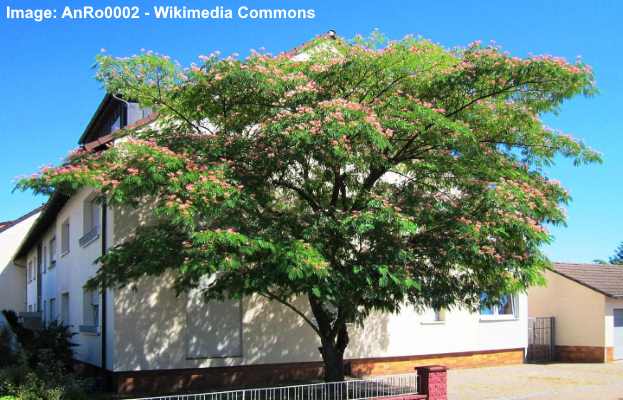
The mimosa tree has beautiful pink fuzzy flowers and is suitable for coastal California gardens
The mimosa tree is attractive with a vase-shaped habit, pink, fuzzy power puff flowerheads, and fern-like foliage. Other names for the mimosa tree are Persian silk tree and pink silk tree.
The outstanding ornamental feature of this exotic tree is its beautiful, pinkish flowers with clusters of fluffy stamens. The mimosa tree leaves fold at night or when touched.
The fast-growing pink silk tree grows up to 20 to 40 ft. (6 – 12 m) tall and wide. Its bipinnate green leaves measure 20” (50 cm) long, and the flat bean-like seed pods are 7” (17 cm) long. The silk tree thrives in USDA zones 6 to 9 and prefers full sun. It’s ideal for planting in coastal gardens.
California flowering tree color: The silk tree flowers are pom-pom-like blooms with pink silky thread clusters that point upward.
California flowering tree identification: Identifying features of the silk tree include its sensitive fern-like leaves, fragrant pink flowers that look like fuzzy pompoms, and long flattened seed pods containing oval-shaped brown seeds.
- USDA Growing Zone: 6-9
- Size: 20-40 feet (6 – 12 meters) tall and wide
- Light: Full sun
- Soil: Well-drained, loamy soil
- Flowering Season: Summer
Golden Rain Tree (Koelreuteria paniculata)
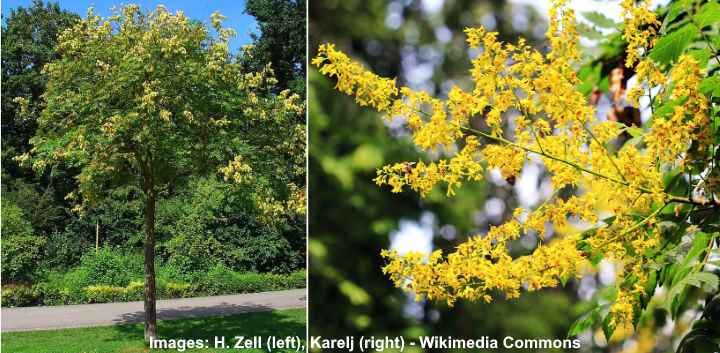
The golden rain tree is a yellow flowering tree that gives ornamental value and shade to California landscapes
The golden rain tree is an attractive ornamental tree with showy clusters of yellow flowers in the summer. Identifying features of the golden rain tree are its long flowering spikes of bright yellow blossoms, bright green foliage, and dangling clusters of papery, triangular seed capsules. In addition, the foliage turns rusty brown in the fall.
This small to medium deciduous golden rain tree grows 30 to 40 ft. (9 – 12 m) tall and wide, making it an ideal choice for gardens with limited space. Its stunning floral displays, attractive foliage, and decorative fruit give it a lot of appeal in a landscape. Suitable for USDA zones 6 to 9.
California flowering tree color: Bright yellow flowers cover the golden rain tree through summer.
California flowering tree identification: The golden rain tree has a rounded canopy, pinnate feathery leaves, bright yellow flowers, and chartreuse lantern-like seed capsules in the fall.
- USDA Growing Zone: 6-9
- Size: 30-40 feet (9 – 12 meters) tall and wide
- Light: Full sun
- Soil: Well-drained, loamy soil
- Flowering Season: Summer
Yellow Bells (Tecoma stans)
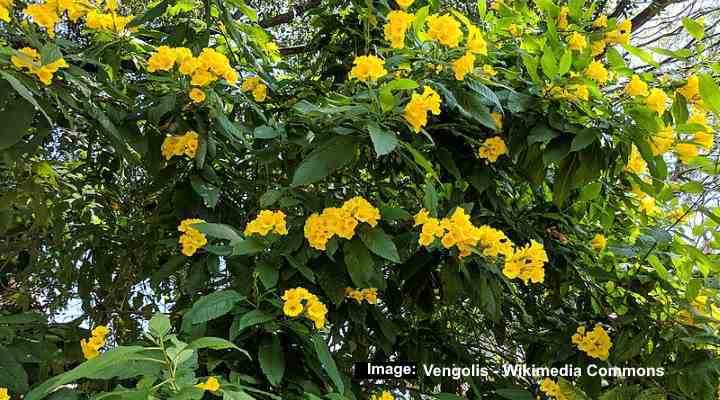
Yellow bells is a small tree with yellow trumpet-shaped flowers that is suitable for dry arid landscapes in California
The flowering yellow bells tree is one of the most floriferous trees for a California landscape. This semi-evergreen small landscaping tree has abundant clusters of bright yellow trumpet-shaped flowers blooming on arching branches. The fragrant golden yellow blossoms contrast nicely with the serrated leaves before developing into long 8” (20 cm) seed pods.
Yellow bells is a semi-evergreen tree that performs best in USDA zones 8 to 11. This native species grows 10 to 25 ft. (3 – 7.5 m) tall and has long, drooping branches, creating an elegant crown 20 ft. (6 m) wide.
California flowering tree color: The yellow bells tree has bright yellow trumpet-shaped flowers that bloom from late spring through summer.
California flowering tree identification: The yellow bells tree is identified by small bright green leaves, yellow funnel-shaped flowers, and dangling brown seed pods.
- USDA Growing Zone: 8-11
- Size: 10-25 feet (3 – 7.5 meters) tall and 20 feet (6 meters) wide
- Light: Full sun
- Soil: Well-drained, sandy or loamy soil
- Flowering Season: Late spring through summer
Southern Magnolia (Magnolia grandiflora)
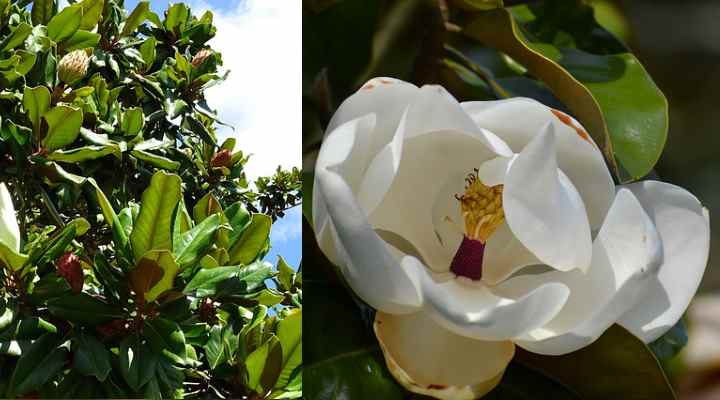
Southern Magnolia (Magnolia grandiflora)
The southern magnolia is a majestic evergreen tree that thrives throughout California. The exotic tree is known for its large, cup-shaped, fragrant white flowers, glossy green leaves, and ornamental cone-like seed pods. The southern magnolia tree provides year-round interest in southwestern gardens, reaching heights up to 80 ft. (24 m) tall.
Southern magnolia trees are ideal shade trees for the hot, humid weather in the Golden State. They tolerate most soil types that have good drainage. You can use southern magnolias as a focal point in a large landscape. The tree’s lush evergreen foliage, sweetly scented creamy-white flowers, and bright red seeds give it year-long ornamental appeal.
- USDA Growing Zone: 7 to 10
- Size: Up to 60 to 80 ft. (18 – 24 m) tall and up to 50 ft. (15 m) wide
- Light: Full sun to partial shade
- Soil: Well-drained, neutral to acidic soils
- Flowering Season: Late spring and throughout summer
Little Gem Magnolia (Magnolia grandiflora ‘Little Gem’)
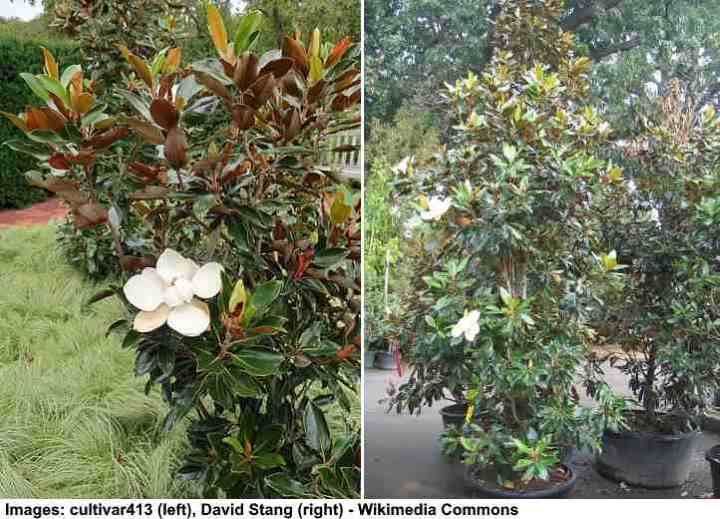
‘Little Gem’ is a dwarf cultivar of Southern magnolia (Magnolia grandiflora)
The ‘Little Gem’ magnolia is a compact evergreen tree, ideal for brightening Californian gardens with large, fragrant white flowers. The dwarf ornamental tree blooms in late spring with brilliant white flowers, contrasting nicely with lustrous, dark green leaves. The saucer-shaped flowers measure 4” (10 cm) in diameter, and the tree’s leaves are 5” (13 cm) long.
‘Little Gem’ is one of the most attractive landscaping trees under 20 feet (6 m) tall for the southwestern yards. The sun-loving tree is ideal for growing in lawns, containers, or as an evergreen privacy hedge. It also performs well in partially shaded conditions in low-maintenance California landscapes.
- USDA Growing Zone: 7 to 9
- Size: 15 to 20 ft. (4.5 – 6 m) tall and 8 to 10 ft. (2.4 – 3 m) wide
- Light: Full sun to partial shade
- Soil: Well-drained, organically rich soil
- Flowering Season: Late spring and throughout summer
Chinese Fringe Tree (Chionanthus retusus)
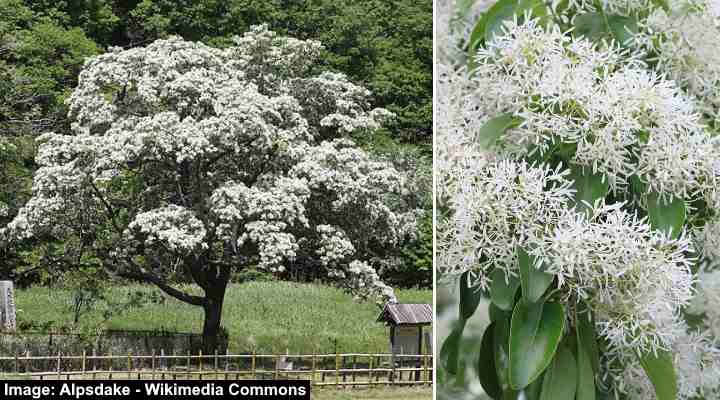
A Chinese fringe tree (Chionanthus retusus) and flowers
The Chinese fringe tree is a stunning flowering tree that blooms throughout spring with abundant white flowers. The tree’s identifying features are its fringe-like white flowers, bright green, leathery leaves, and clusters of dark blue fruit in late summer. The slow-growing deciduous tree creates breathtaking floral displays every spring.
Chinese fringe trees grow up to 20 ft. (6 m) tall and have a rounded shape and dense deciduous foliage. An attractive feature of the tree is the snow-like ground covering when the masses of petals drop in early summer. You can also plant Chinese fringe trees as specimen trees or mixed border plants in full sun or partial shade.
- USDA Growing Zone: 5 to 9
- Size: 10 to 20 ft. (3 – 6 m) tall and wide
- Light: Full sun to partial shade
- Soil: Well-drained, fertile, slightly acidic soils
- Flowering Season: Late spring and early summer
Flowering Dogwood (Cornus florida)
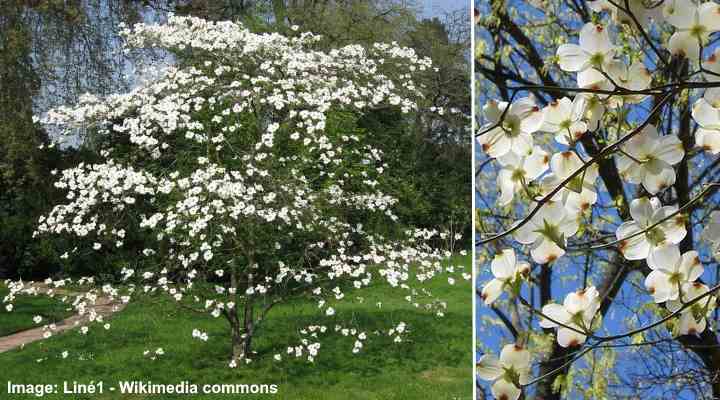
A flowering dogwood (Cornus florida) tree and flowers
The flowering dogwood is a beautiful white-flowering tree, ideal for garden landscapes in California. The native tree has showy, four-petaled, star-shaped flowers blooming in spring on bare branches. The ornamental tree also produces mid-green oval leaves and clusters of orange-red fruit in summer. The tree bark is distinctive, resembling alligator skin.
Flowering dogwood trees grow up to 30 ft. (9 m) tall. They are versatile ornamental trees that thrive in California’s varied climates. You can plant the small tree as a specimen plant, lawn tree, or near a patio for summer shade. It is also deer-resistant and produces the best blooms growing in partial shade.
- USDA Growing Zone: 5 to 9
- Size: 15 to 30 ft. (4.5 – 9 m) tall and wide
- Light: Partial shade, but tolerates full sun
- Soil: Well-drained, evenly moist, neutral to acidic soils
- Flowering Season: Spring
Pacific Dogwood (Cornus nuttallii)
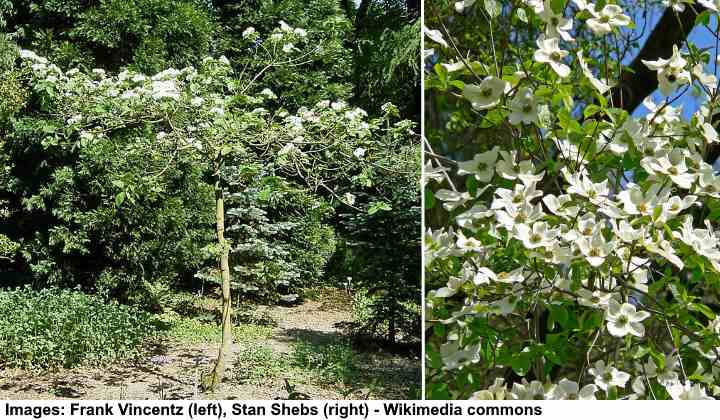
A Pacific dogwood (Cornus nuttallii) tree and flowers
The Pacific dogwood is a stunning flowering tree native to California. The beautiful deciduous has eye-catching creamy-white flowers consisting of six bract-like petals. These flower until mid-summer when the showy blooms give way to orange-red berry-like fruits. The tree’s foliage is mid-green oval leaves that turn orange in the fall.
Pacific dogwoods are medium-sized trees not growing taller than 40 ft. (12 m). Dogwoods prefer moist, well-drained soil and partial shade. Therefore, they are great for woodland gardens or shady landscape areas. The popular ornamental trees also perform well as lawn or patio trees, and they help to add color to cottage gardens.
- USDA Growing Zone: 7 to 9
- Size: 15 to 40 ft. (4.5 – 12 m) tall and 10 to 25 ft. (3 – 7 m) wide
- Light: Full sun or partial shade
- Soil: Moist, well-drained, humus-rich soil
- Flowering Season: From mid-spring through mid-summer
Japanese Flowering Cherry (Prunus serrulata)
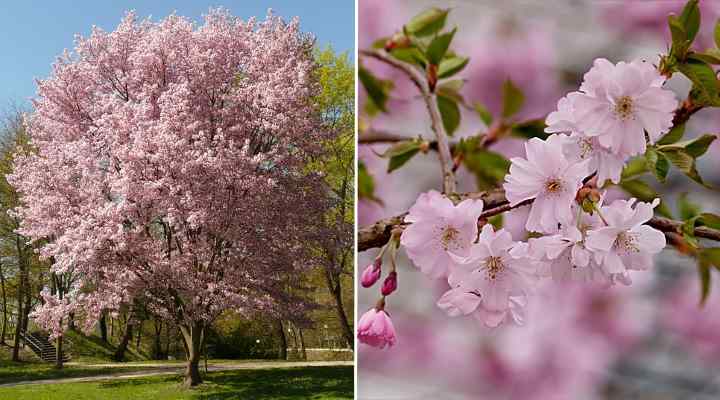
A Japanese flowering cherry (Prunus serrulata) tree and flowers
The Japanese flowering cherry fills California landscapes every spring with stunning pink or white blossoms. This deciduous flowering tree is covered in showy single or double flower clusters. The tree has dark green leaves with serrated edges that turn coppery bronze, red, or orange in the fall.
Japanese flowering cherries are one of the most spectacular flowering trees for the Southwest. The spring blossoms create stunning floral displays, and the colorful foliage adds summer and fall interest. Also, the chestnut-brown bark looks attractive in winter after the leaves have dropped. Appearing in early spring, the white flowers create a breathtaking display of color.
- USDA Growing Zone: 5 to 8
- Size: 15 to 25 ft. (4.6 — 7.6 m) tall and wide
- Light: Full sun to partial shade
- Soil: Well-drained soil
- Flowering Season: Early spring
California Lilac (Ceanothus)

A California lilac (Ceanothus) tree and flowers
California lilac is a beautiful blue-flowering shrub that can grow as a tree. Native to the southwestern United States, the multi-stemmed plant blooms continually from spring through winter. Its blooms are conical clusters of small blue, white, or pink flowers. The drought-tolerant trees have heart-shaped, glossy green, spiny, holly-like leaves,
California lilacs are ideal for attracting bees, butterflies, and other pollinators to your backyard. The deer-resistant tree looks stunning as a focal point, specimen plant, or planted for erosion control. Because they tolerate salt spray, the small ornamental trees are perfect for planting in front or backyards on the Pacific Coast.
Some of the smaller varieties of California lilacs don’t grow more than two feet (0.6 m) tall and are ideal for ground cover. The flowering landscaping plants also work well for xeriscaping in dry, rocky, or sandy soils.
- USDA Growing Zone: 7 to 10
- Size: 2 to 20 ft. (0.6 – 6 m) tall and up to 25 ft. (7.6 m) wide
- Light: Full sun to partial shade, although they all perform best in full sun
- Soil: Neutral to alkaline soils that have excellent drainage
- Flowering Season: From spring until the onset of winter
Tipuana (Tipuana tipu)
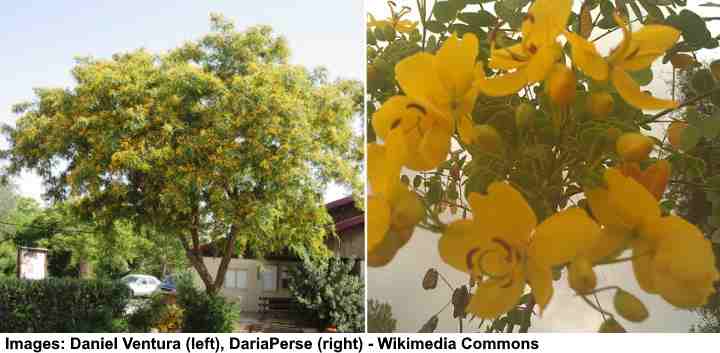
A Tipuana tree (Tipuana tipu) and flowers
The Tipuana tree is a fast-growing, semi-evergreen tree widely planted in California for shade in backyards. The medium-sized tree blooms in late summer with vibrant yellow flowers. Its rounded, umbrella-like canopy has dense fern-like foliage and pinnate leaves up to 10” (25 cm) long. Tipuana trees can grow up to 70 ft. (30 m) tall in California.
In addition to its aesthetic appeal, the Tipuana tree is valued for its tolerance to drought and poor soil conditions. Also, its dense foliage and strong trunk make the Tipuana tree excellent as a windbreak or for providing shade and habitat for native wildlife.
Before planting a Tipuana tree in a California landscape, it’s good to know that it can become invasive. Also, its root system can lift sidewalks or affect foundations if planted too close to structures.
- USDA Growing Zone: 9 to 11
- Size: Typically 30 to 70 ft. (9 – 21 m) tall and 100 ft. (30 m) wide
- Light: Full sun
- Soil: Well-drained, adaptable to various soil types
- Flowering Season: Late spring and early summer
Coral Tree (Erythrina crista-galli)
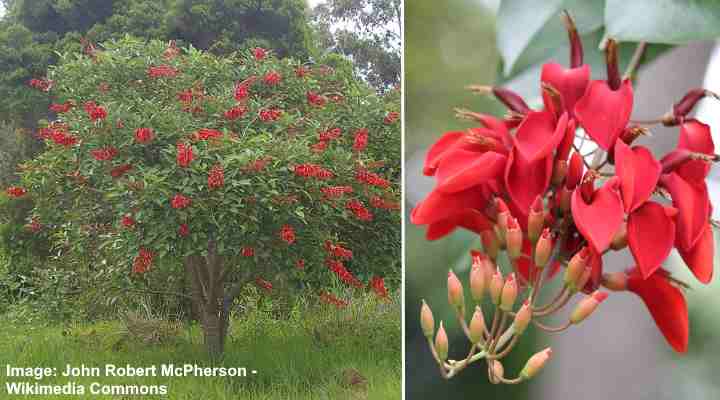
A coral tree (Erythrina crista-galli) and flowers
The coral tree is a small red-flowering ornamental tree that thrives in warm, humid climates. Ideal for Californian gardens, the coral tree adds a vibrant splash of color thanks to its stunning coral-red pea-like flowers in drooping clusters. The spiny branches have dark green, leathery leaves 6” (15 cm) long.
The tropical tree thrives in at least six hours of daily sunlight, where it blooms from mid-spring until the fall. Additionally, the coral tree produces attractive seed pods 8” (20 cm) long that persist on the tree throughout winter. The tree is valued for its attractive flowers and foliage, providing shade and color in hot California summers.
Coral trees are relatively easy to grow and are drought-tolerant once established. They are ideal for your landscape if you have sandy or clay soils, as the tree is highly versatile.
- USDA Growing Zone: 9 to 11
- Size: Up to 15 to 20 ft. (4.5 – 6 m) tall and up to 15 ft. (4.5 m) wide
- Light: Full sun
- Soil: Sandy, moist, well-drained soils
- Flowering Season: Spring, summer, and fall
California Flannelbush (Fremontodendron californicum)
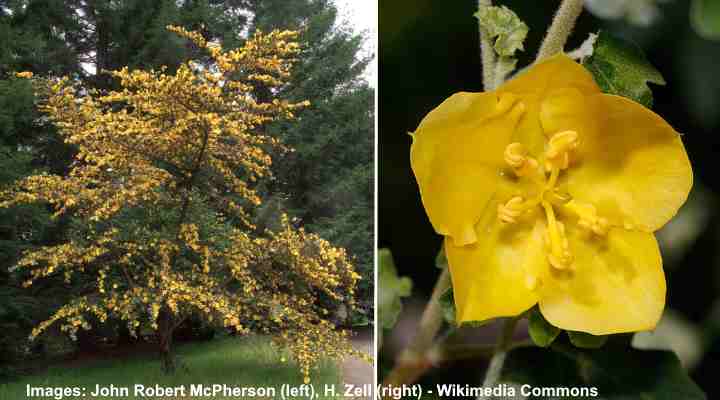
A California flannelbush (Fremontodendron californicum) and a close up image of its flower
The California flannelbush is a small native evergreen tree with stunning yellow flowers that bloom in late spring. The broadleaf tree is identified by its saucer-shaped yellow blossoms 3” (7.5 cm) across, leathery leaves with round lobes, and conical seed capsules. The small shrub-like tree grows up to 20 ft. (6 m) tall.
Its drought, heat, and humidity tolerance make this flannelbush variety ideal for California landscapes. In full sun, the stunning ornamental tree thrives in gravelly to poor soils. You can also plant the California flannelbush successfully in coastal regions of California to add yellow color and texture to garden landscapes.
- USDA Growing Zone: 8 to 10
- Size: Up to 8 to 20 ft. (2.4 – 6 m) tall and up to 10 ft. (3 m) wide
- Light: Full sun
- Soil: Sandy, moist, well-drained soils
- Flowering Season: Spring, summer, and fall
Blue Elderberry (Sambucus cerulea or Sambucus nigra subsp. caerulea)
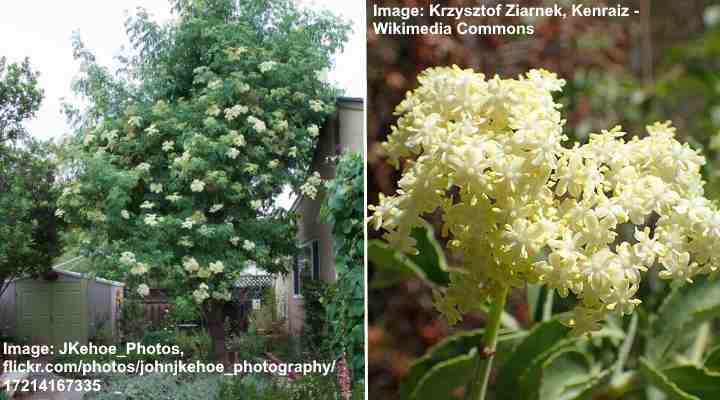
A blue elderberry (Sambucus cerulea or Sambucus nigra subsp. caerulea) tree and flowers
The blue elderberry is a versatile and attractive small tree native to the Western United States. The shrub-like tree blooms from spring through fall with flat-topped clusters of small, fragrant, creamy-white flowers. The tree’s foliage has pinnately compound leaves, and clusters of dark blue edible berries appear in late summer.
Blue elderberry shrubs and trees are well-suited to California gardens. They can tolerate wet or dry soils and withstand drought periods. The bushy trees can grow as specimen plants or be planted together in informal hedgerows, shrub borders, or naturalized areas.
It’s important to note that only mature fruits are edible when cooked. Otherwise, all parts of the plant are toxic.
- USDA Growing Zone: 4 to 9
- Size: 20 to 30 ft. (6 – 9 m) tall and wide
- Light: Full sun to partial shade
- Soil: Well-drained, loamy soils
- Flowering Season: Late spring for several weeks through to early fall
California Ash (Fraxinus dipetala)

California ash (Fraxinus dipetala) leaves and flowers
The California ash is a medium-sized tree with creamy white flowers blooming in mid to late spring. It’s the only ash tree native to California. The deciduous tree has dangling clusters of small flowers and pinnately compound leaves. After flowering, the tree produces masses of winged fruits called samaras.
California ash trees can grow up to 25 ft. (7.6 m) tall, but usually shorter. Other characteristics of the native tree are its open, spreading canopy and attractive greenish-gray bark. In the fall, the tree’s foliage turns bright gold, adding a pop of color to the landscape.
The California ash is a popular choice as a shade tree in residential landscapes. It is also a valuable tree for wildlife, providing habitat and food for birds and insects. Its native habitat is the dry slopes in California’s foothills, woodlands, and chaparrals.
- USDA Growing Zone: 7 to 10
- Size: Up to 25 ft. (7.6 m) tall and 15 to 20 ft. (4.5 – 6 m) wide
- Light: Full sun to partial shade
- Soil: Adaptable to various soil types, drought-tolerant once established
- Flowering Season: Spring
Desert Ironwood (Olneya tesota)
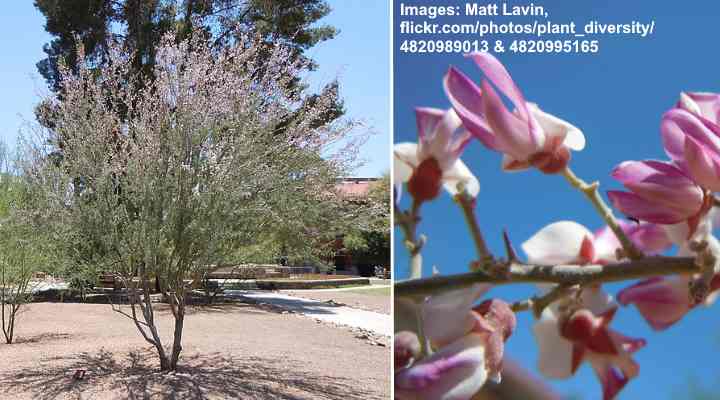
A desert ironwood (Olneya tesota) tree and flowers
The desert ironwood is a unique, hardy flowering tree native to the desert regions of California. Blooming in spring, the desert ironwood is known for its beautiful clusters of lavender or purple-pink flowers and dense, dark green foliage. The hardy, heat-tolerant tree has a broad, spreading crown and branches covered in sharp spines.
Desert ironwood trees are adapted to arid desert conditions, making them perfect for xeriscape gardens. The evergreen foliage remains on the tree throughout the year, and pale, rose-purple flowers emerge in spring before new growth. Also, the tree produces bean-like seeds that attract wildlife in late summer and fall.
- USDA Growing Zone: 9 to 11
- Size: 15 to 30 ft. (4.5 – 9 m) tall and wide, rounded canopy
- Light: Full sun
- Soil: Well-drained, sandy, gravelly, loamy, or clay soil
- Flowering Season: Spring
Tulip Tree (Liriodendron tulipifera)
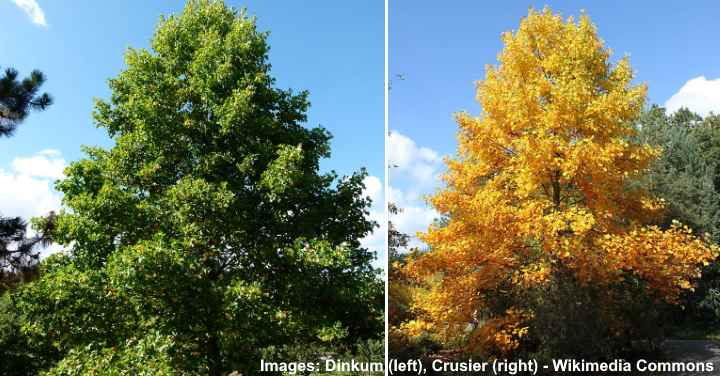
Tulip trees – summer and autumn foliage
The tulip tree is a magnificent deciduous tree that fills California landscapes with yellow tulip-shaped flowers. Blooming in late spring and early summer, the vibrant yellow flowers offer spectacular floral displays with glossy, bright green foliage. The leaves—also tulip-shaped—turn vibrant yellow in the fall.
Tulip trees are tall deciduous trees that can grow up to 80 ft. (24 m) tall. The flowering tree is identified by its medium to narrow crown, star-shaped leaves, and yellow-orange cup-shaped flowers. Their broad, dense crown makes tulip trees ideal for shade in hot, humid climates.
The trees require plenty of moisture in the summer heat. Therefore, tulip trees are unsuitable for desert landscapes. They perform better when the ground is consistently moist.
- USDA Growing Zone: 4 to 9
- Size: 60 to 80 ft. (18 – 24 m) tall and 30 to 40 ft. (9 – 12 m) wide
- Light: Full sun to partial shade
- Soil: Well-drained, consistently moist, fertile soils
- Flowering Season: Late spring through fall
Oregon Crab Apple (Malus fusca)

An Oregon crab apple (Malus fusca) tree and flowers
The Oregon crab apple is a flowering tree native to the Western United States. The fruit tree has a distinctive vase-shaped crown, stunning spring blossoms in shades of white and pink, and small, red or yellow crabapples. The attractive flowers have four oval petals in a star shape.
The Oregon crab apple is an excellent choice for landscaping small to medium garden landscapes. It’s an adaptable multi-trunked tree that performs well in full sun to heavy shade and requires plenty of moisture in the summer. Its tolerance to salt air and wet soils makes it ideal for planting along Pacific coastal regions.
- USDA Growing Zone: 5 to 8
- Size: 15 to 40 ft. (4.5 – 12 m) tall and wide
- Light: Full sun, partial shade, full shade
- Soil: Well-drained, fertile soils that are consistently moist
- Flowering Season: Spring
Paperbark Tea Tree (Melaleuca quinquenervia)

A paperbark tea tree (Melaleuca quinquenervia) and flowers
The paperbark tea tree is a medium-sized evergreen tree known for its striking peeling bark and aromatic leaves. An easily identifying feature of this tree is its creamy-white bottlebrush-like flowers. These showy blooms emerge in late spring and continue blooming until fall. The small to medium-sized trees don’t grow taller than 50 ft. (15 m).
Although native to Australia, paperback trees are popular in California landscapes due to their adaptability to various soil types and climates. The tree’s cream-colored bottlebrush-like flowers bloom in the summer, attracting bees and butterflies. Another attractive feature is the tree’s papery bark that peels off in strips, adding visual interest and texture to landscapes.
In North America, Melaleuca quinquenervia goes by the name punk tree.
- USDA Growing Zone: 9 to 11
- Size: 30 to 50 ft. (9 – 15 m) tall and up to 10 ft. (3 m) wide
- Light: Full sun to partial shade
- Soil: Well-drained, sandy or loamy soils
- Flowering Season: Blooms throughout the year in warm climates
Catalina Ironwood (Lyonothamnus floribundus)
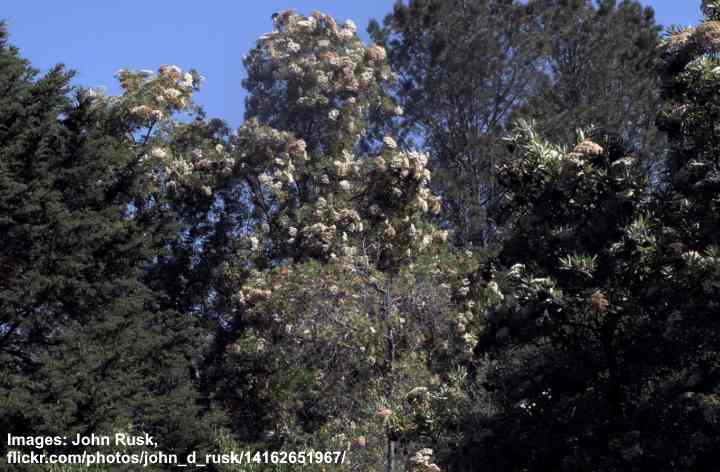
A Catalina ironwood tree (Lyonothamnus floribundus)
The Catalina ironwood is a unique white-flowering tree native to California’s Channel Islands. The evergreen tree has foliage of fern-like leaves 6” (15 cm) long, flattened sprays of five-petalled white flowers, and cinnamon-red exfoliating bark. The eye-catching tree has a conical canopy, adding to its ornamental appeal for California gardens.
Catalina ironwood trees are ideal for landscaping coastal gardens. The tree’s fibrous bark, feathery foliage, and white flowers add texture and year-long color to landscapes. Also, the tree tolerates salt spray and windy conditions, ideal for planting as a windbreak or screen in beachfront gardens.
They are also drought-tolerant once established. These trees can be used as a focal point in a garden or as a shade tree, providing a cool and tranquil atmosphere.
- USDA Growing Zone: 8 to 10
- Size: 20 to 40 ft. (9 m) tall and 15 to 20 ft. (4.5 – 6 m) wide
- Light: Full sun or light shade
- Soil: Well-drained, sandy or loamy soil
- Flowering Season: Late spring to early summer
Pineapple Guava (Feijoa sellowiana)
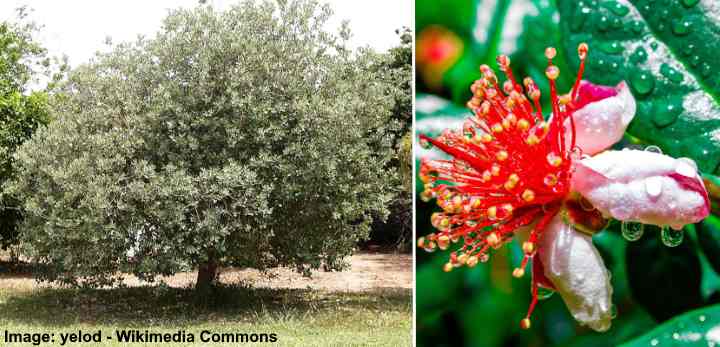
A pineapple guava (Feijoa sellowiana) tree and a flower
Pineapple guava is a versatile evergreen shrub or small tree native to South America. It is valued for its attractive foliage, unique pineapple-like fruit, and beautiful flowers. The flowers have purple-tinged white petals with striking red stamens. The leaves are leathery and dark green with fuzzy, silvery undersides.
The pineapple guava produces edible fruit that is green and egg-shaped. The fruit has a sweet and tangy flavor, reminiscent of a combination of pineapple, guava, and mint. The flesh is soft and creamy, with a jelly-like texture. You can eat the fruit fresh or use it in various culinary dishes, such as desserts, jams, and beverages.
In addition to its delicious fruit, the pineapple guava also has ornamental value. It produces showy, pink and white flowers in late spring or early summer. The flowers have a pleasant fragrance and attract pollinators like bees and butterflies. It’s useful as a flowering hedge, privacy screen, or blossom tree.
- USDA Growing Zone: 8 to 11
- Size: 10 to 25 ft. (3 – 7.6 m) tall and wide
- Light: Full sun to partial shade
- Soil: Well-drained, fertile soil
- Flowering Season: Late spring to early summer
Primrose Tree (Lagunaria pattersonii)

A primrose tree (Lagunaria pattersonii) and flowers
The primrose tree blooms from summer to fall with pink hibiscus-like flowers, adding tropical elegance to California gardens. The tree is identified by its pyramidal habit, glossy dark green leathery leaves, and stunning clusters of pinkish-white flowers. After flowering, fuzzy brown seed capsules containing kidney-shaped seeds appear.
Also called Norfolk Island hibiscus or cow itch tree, evergreen primrose trees can grow up to 30 ft. (9 m) tall. In frost-free climates, you can plant the tree as a focal point in your landscape or use several trees as a privacy screen or windbreak. The tropical tree is well-suited for coastal regions and can tolerate salty air and sandy soils.
- USDA Growing Zone: 9 to 11
- Size: 20 to 30 ft. (6 – 9 m) tall and 20 ft. (6 m) wide
- Light: Full sun
- Soil: Well-drained, medium moisture soils
- Flowering Season: From summer through fall
Smoke Tree (Psorothamnus spinosus)
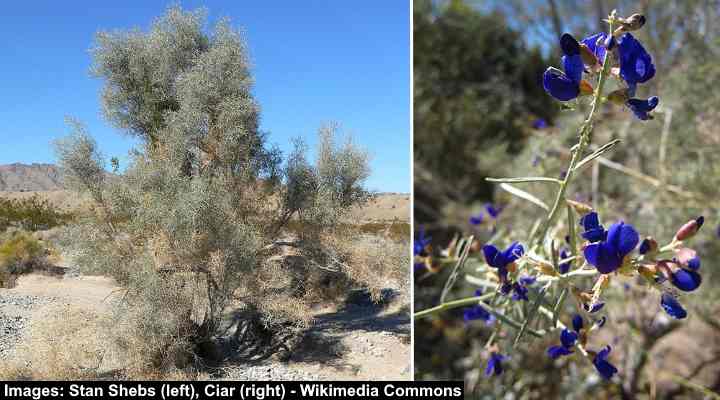
A smoke tree (Psorothamnus spinosus) and flowers
The smoke tree is an eye-catching small tree that blooms with spikes of indigo-blue flowers. The unusual tree gets its smoky appearance from the smoky-gray, almost leafless thorny branches. Also, its fragrant bluish flowers resemble puffs of smoke, adding to the desert tree’s charm and exoticness.
Also called the smokethorn tree, the striking desert tree grows up to 20 ft. (6 m) tall in its native range of southern California. Its tolerance to arid conditions makes the tree an ideal addition to xeriscape gardens and drought-tolerant landscapes. It’s also useful as an accent tree or for attracting wildlife to barren landscapes.
Smoke trees are relatively low-maintenance and tolerate harsh growing conditions, making them a great choice for California’s dry climate.
- USDA Growing Zone: 5 to 9
- Size: 15 to 20 ft. (4.5 – 6 m) tall and wide
- Light: Full sun to partial shade
- Soil: Well-drained, adaptable to various soil types, especially sandy, gravelly soils
- Flowering Season: Summer
Sweetshade Tree (Hymenosporum flavum)
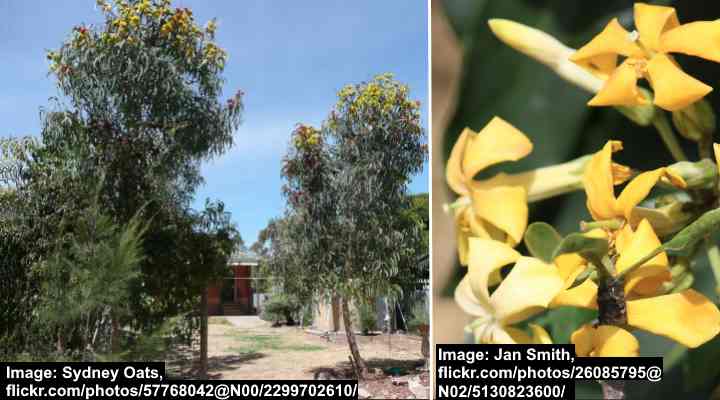
Sweetshade trees (Hymenosporum flavum) and flowers
The sweetshade tree is a beautiful yellow-flowering evergreen tree for gardens in California. The tropical tree features glossy evergreen foliage, clusters of sweetly scented star-shaped honey-yellow flowers, cinnamon-brown under-bark, and a graceful, upright form. The dainty flowers have a trumpet form and grow in airy clusters.
The sweetshade tree has a slender, tidy form, ideal for any size of garden in mild winter climates. The sweetshade tree grows up to 30 feet (9 m) tall and only 20 ft. (6 m) wide.
Thanks to its evergreen foliage, the tree provides lush color and texture when the creamy-yellow or dark gold flowers are not covering the tree’s canopy. It is low-maintenance and drought-tolerant and thrives in a range of soil types, including sandy and clay soils.
- USDA Growing Zone: 9 to 11
- Size: Up to 30 ft. (9 m) tall and 20 ft. (6 m) wide, however, it can grow up to 50ft. (15 m) tall.
- Light: Full sun to partial shade
- Soil: Well-drained, fertile soils
- Flowering Season: Spring and early summer
Water Gum (Tristania laurina)
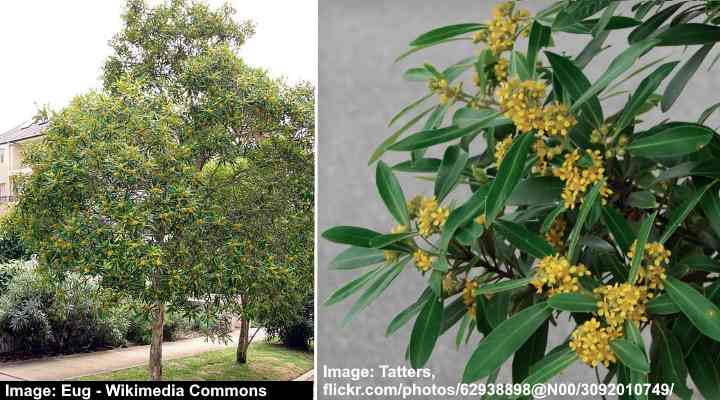
Water gum (Tristania laurina) trees and flowers
The water gum is a fast-growing evergreen tree with a dense canopy and showy, fragrant yellow flowers. Blooming in spring and summer, this tree adds color and texture to California landscapes. It’s identified by its clusters of dainty yellow flowers, whorls of elongated willow-like leaves, and small round fruit capsules.
Water gum trees grow up to 35 ft. (10 m) tall and have a dense, rounded canopy. The tree is ideal for providing shade in hot climates. Also, its tolerance to drought, heat, and constant sunshine makes it ideal for desert garden landscapes in Southern California. As a bonus, its beautiful fragrant flowers and seeds attract birds and other wildlife.
The tree also tolerates salt spray, making it a good addition to coastal landscapes.
- USDA Growing Zone: 10 to 12
- Size: 20 to 35 ft. (6 – 10 m) tall and 15 to 30 ft. (4.5 – 9 m) wide
- Light: Full sun to partial shade
- Soil: Loamy or sandy soil, it’s drought tolerant when established
- Flowering Season: Spring and summer
Victorian Box or Mock Orange (Pittosporum undulatum)
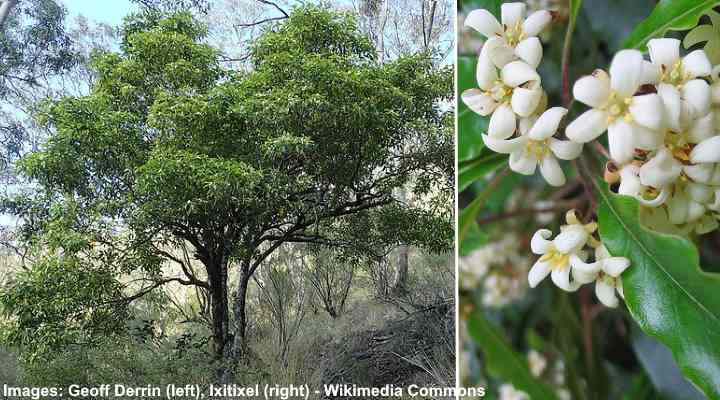
A Victorian box or mock orange (Pittosporum undulatum) tree and flowers
The Victorian box—also called mock orange—is a medium-sized evergreen tree that blooms in spring and summer with clusters of brilliant white flowers. The tree is identified by its pyramidal shape, glossy lanceolate leaves with wavy edges, and bunches of orange berries. The small, creamy white, fragrant flowers fill the air in late spring and early summer.
Mock orange trees have a shrub growth habit, making them highly versatile. Apart from growing as a large shade tree, you can train the bushy tree to grow as a hedge, screen, or windbreak in California gardens. It is also drought-tolerant and can thrive in a variety of well-draining soil types.
- USDA Growing Zone: 9 to 11
- Size: 30 to 50 ft. (9 m) tall and wide
- Light: Full sun, partial shade, full shade
- Soil: Well-drained sandy or loamy soils and tolerate acidic, neutral, or slightly alkaline conditions
- Flowering Season: Early spring to early summer
Gold Medallion Tree (Cassia leptophylla)
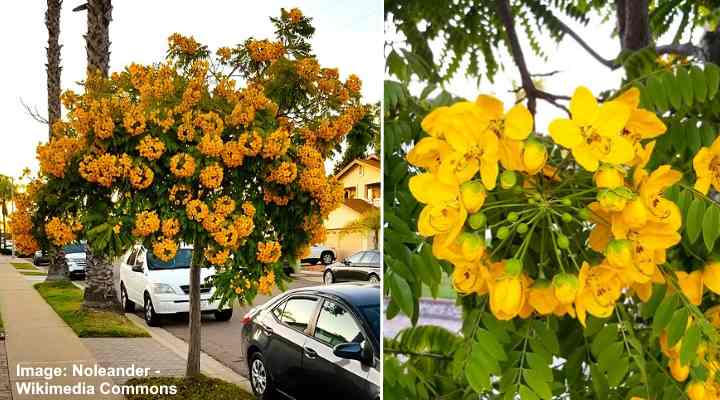
A gold medallion tree (Cassia leptophylla) and flowers
The gold medallion tree is a striking yellow-flowering tree that adds a burst of vibrant color to California landscapes. The tree blooms in summer and early fall with five-petalled golden-yellow flowers. These large, showy flowers contrast nicely with large pinnate leaves. After flowering, bean-like seed pods appear and persist from fall through winter.
The fast-growing gold medallion has a spreading, open crown and slightly drooping branches. Not growing taller than 25 ft. (7.6 m), the gold medallion tree is ideal in small gardens as a shade tree or lawn specimen plant. Its open crown and fern-like foliage provide dappled shade in gardens throughout the warmest regions of the Golden State.
- USDA Growing Zone: 10 to 12
- Size: 20 to 25 ft. (6 – 7.6 m) tall and 20 ft. (6 m) wide
- Light: Full sun
- Soil: Well-drained, medium-moisture, moderately fertile soils
- Flowering Season: Summer and early fall
Pink Trumpet Tree (Handroanthus heptaphyllus)
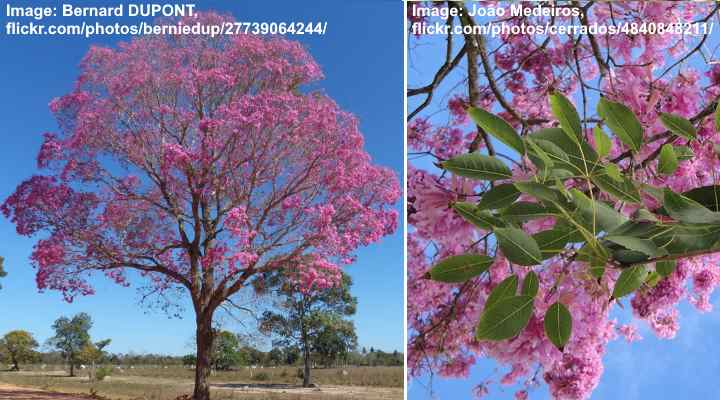
Pink trumpet trees (Handroanthus heptaphyllus) and flowers
The pink trumpet tree is a stunning flowering tree covered in pink and lavender trumpet-like flowers in winter and spring. Highly prized for its vibrant floral displays, the tree is identified by its large, glossy, lance-shaped leaves and clusters of pink flowers. It’s a popular landscaping choice for California residents.
As one of California’s most spectacular flowering trees, the pink trumpet tree can grow up to 50 ft. (15 m) tall. Its spreading, vase-shaped canopy, early spring blooms, long seed pods, and dense foliage give it tremendous appeal in warm climates. It’s also one of the few ornamental landscaping trees to bloom throughout winter in California.
- USDA Growing Zone: 10 and 11
- Size: 40 to 50 ft. (12 – 15 m) tall and wide
- Light: Full sun
- Soil: Well-drained, slightly acidic loamy soils
- Flowering Season: Late winter and early spring
Blackhaw Viburnum (Viburnum prunifolium)
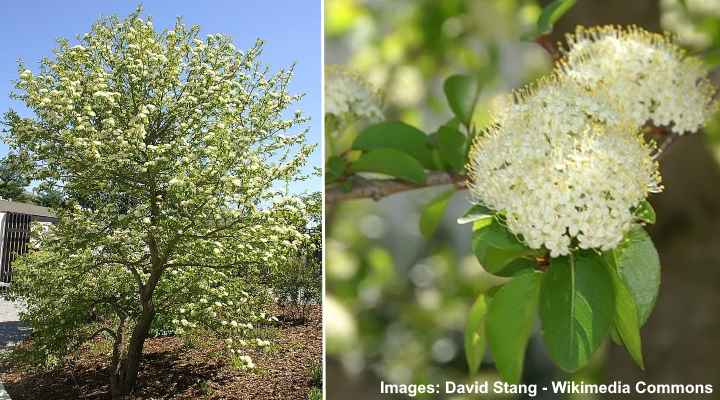
A blackhaw viburnum tree and flowers
The blackhaw viburnum is a white-flowering ornamental shrub or small tree that thrives throughout California. Blooming in spring, the small, bushy tree has masses of attractive flat-topped clusters of small, star-shaped white flowers. It has attractive glossy green leaves and attractive fall colors of red and purple shades.
Blackhaw viburnums also produce clusters of pink-rose berries in summer that ripen to blue-black by late fall. The small tree doesn’t grow taller than 15 ft. (4.5 m), making it ideal for landscaping small, compact front or backyards. You can also plant the shrub-like tree in borders or as a hedge, foundation planting, or privacy screen.
- USDA Growing Zone: 3 to 9
- Size: 12 to 15 ft. (3.6 – 4.5 m) tall and up to 12 ft. (3.6 m) wide
- Light: Full sun to partial shade
- Soil: Well-drained, moist soils, but adapts to compacted, poor, moist, dry soils
- Flowering Season: Mid to late Spring
Island Tree Poppy (Dendromecon harfordii)
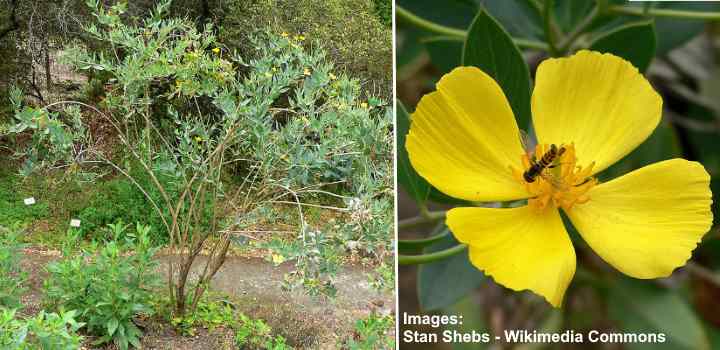
An island tree poppy (Dendromecon harfordii) and its flower
The island tree poppy is a stunning small tree blooming in spring with masses of bright yellow flowers. Native to California, the evergreen tree has four-petalled poppy-like yellow blooms and blue-green oval leaves. The island tree poppy can thrive in dry and rocky conditions, making it a great choice for xeriscaping or drought-tolerant gardens.
This shrub-like tree doesn’t grow taller than 20 feet (6 m). Its tolerance for salt spray, drought, and strong winds makes it ideal for landscaping yards along the Pacific Coast. Also, its everblooming, bright yellow flowers, and leathery leaves add year-long color and texture to California landscapes.
It’s also suitable as a dry shade plant for underplanting larger trees or shrubs.
- USDA Growing Zone: 8 to 10
- Size: 8 to 20 ft. (2.4 – 6 m) tall and wide
- Light: Full sun to partial shade
- Soil: Well-drained, sandy or rocky soil
- Flowering Season: Late spring and summer and blooms periodically throughout the year
Pomegranate Tree (Punica granatum)
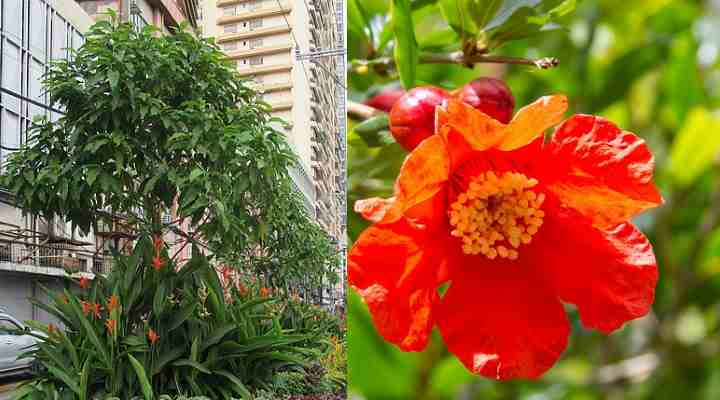
A pomegranate tree (Punica granatum) and its flower
The pomegranate tree is a large shrub or small deciduous tree with vibrant trumpet-shaped red flowers. The stunning scarlet blooms have crepe-like petals and bloom for several weeks from late spring. The leaves are narrowly oblong, emerging bronze in spring and turning yellow in the fall. The shrub-like tree grows up to 20 ft. (6 m) tall.
Pomegranate trees are known for their red flowers and delicious fruit. They are easy to grow and tolerate various soil types. Apart from producing large fruits, the ornamental tree is useful for foundation planting, privacy hedges, or as a specimen tree. They also grow well in containers if you have a smaller garden, patio, or balcony.
- USDA Growing Zone: 7 to 10
- Size: 6 to 20 ft. (1.8 – 6 m) tall and up to 15 ft. (4.5 m) wide
- Light: Full sun
- Soil: Well-drained, moderately fertile soil
- Flowering Season: Late spring and early summer, and some varieties bloom throughout the year in warm climates
Chitalpa (Chitalpa x tashkentensis)

A chitalpa tree (Chitalpa x tashkentensis)
The chitalpa is a fast-growing tree with stunning clusters of funnel-shaped white flowers blooming in midsummer and early fall. The small to medium-sized tree has a vase-shaped canopy, medium green willow-like leaves, and conical clusters of white and pink trumpet-like flowers. There can be up to 40 flowers per panicle.
Chitalpas are versatile trees that can be used as shade trees, specimen trees, or as a colorful addition to a mixed border. The summer-flowering tree brightens small gardens or patios. It is an excellent choice for California gardens that experience long, hot summers.
- USDA Growing Zone: 6 to 11
- Size: Up to 20 to 35 ft. (6 – 10 m) tall and wide
- Light: Full sun or partial shade
- Soil: Well-drained, slightly alkaline soils in deep, moderately fertile
- Flowering Season: From mid-summer through fall
Strawberry Tree (Arbutus marina)
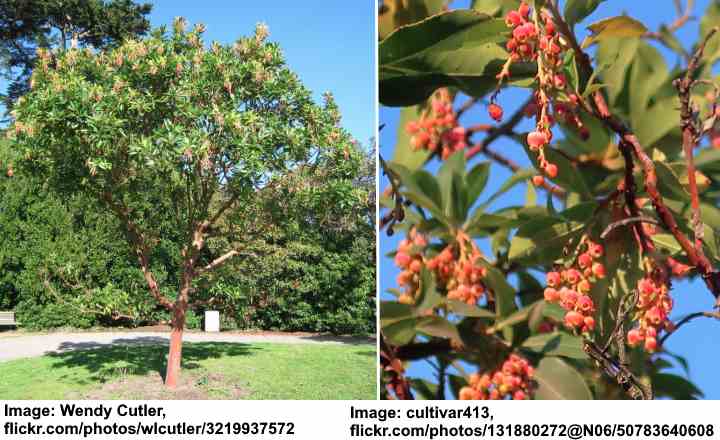
A strawberry tree (Arbutus marina) and flowers
The evergreen strawberry tree is known for its striking bell-shaped pink flowers. Blooming from fall to mid-winter, the strawberry tree has glossy green leathery leaves on reddish stems, clusters of dangling pink fragrant flowers, and round, juicy strawberry-like fruits. Growing less than 15 ft. (4.5 m), it’s a great flowering tree for landscaping in California.
The strawberry tree can grow as a large shrub or small tree. It performs well in coastal gardens as a hedge, foundation planting, shrub border, or specimen plant. Its fragrant flowers attract butterflies, bees, birds, and hummingbirds.
- USDA Growing Zone: 6 to 9
- Size: Up to 6 to 15 ft. (1.8 – 4.5 m) tall and wide
- Light: Full sun to partial shade
- Soil: Well-drained, acidic, moist soils and tolerant of drought once established
- Flowering Season: Late summer and fall
Sweet Acacia Tree (Vachellia farnesiana or Acacia farnesiana)

A sweet acacia tree and flowers
The sweet acacia is a fast-growing semi-evergreen tree native to Southern California. The sweet acacia tree blooms in late winter and early spring with masses of fragrant golden-yellow puff-ball flowers. The bright yellow, highly scented blooms grow in clusters and appear sporadically throughout the year. The puffy yellow flowers give way to cylindrical seed pods.
The canopy of the heat-loving small ornamental tree is vase-shaped and has zig-zag stems covered in sharp thorns. Its foliage consists of feathery leaves that remain green throughout the year in warm winter regions.
The sweet acacia tree is low-maintenance and drought-tolerant, and thrives in the arid regions of California. It’s also tolerant of salt spray and windy conditions, making it ideal for coastal gardens. Ideal for small garden landscapes on the west coast, it is popular for growing as a security barrier, foundation planting, or specimen tree.
- USDA Growing Zone: 9 to 11
- Size: 15 to 20 ft. (4.5 – 6 m) tall and wide
- Light: Full sun
- Soil: Well-drained, sandy or loamy, loose, dry soil
- Flowering Season: Late winter through spring and sporadically in summer
Related articles:
